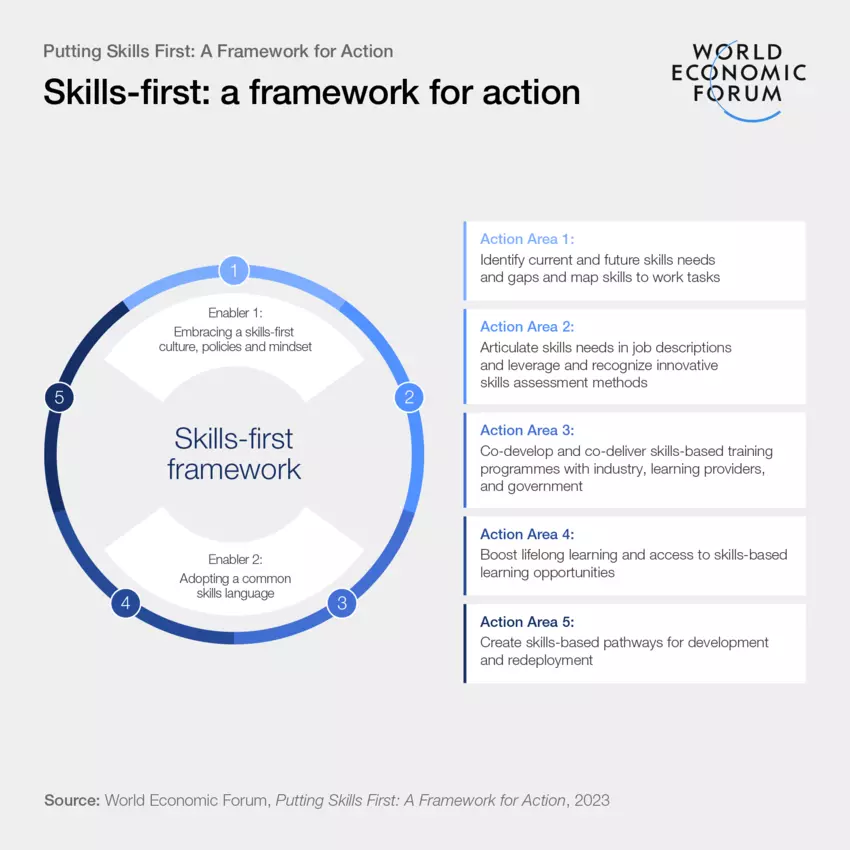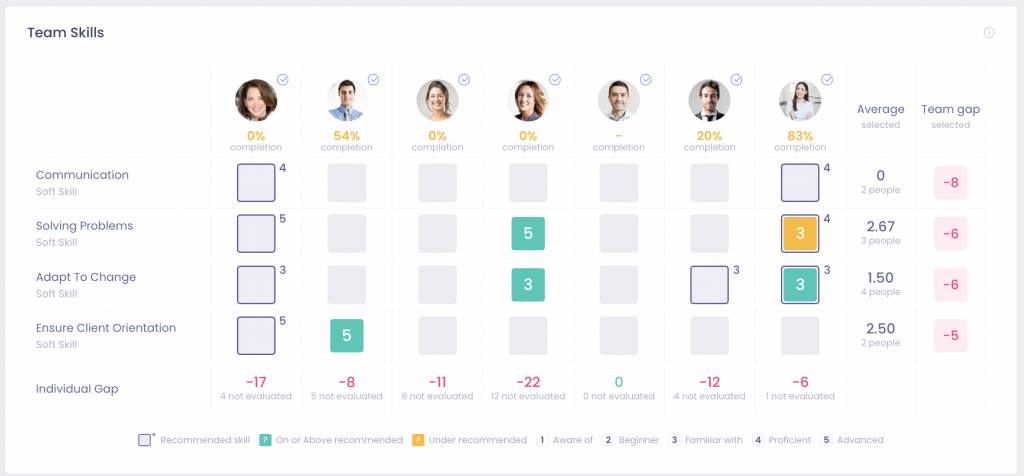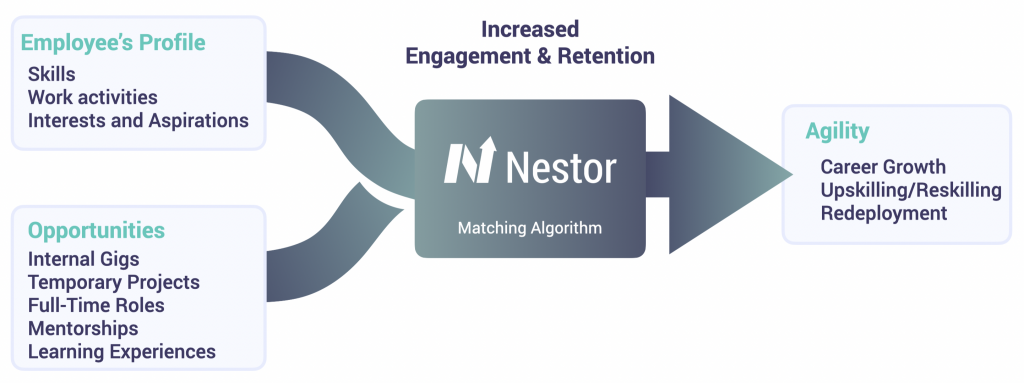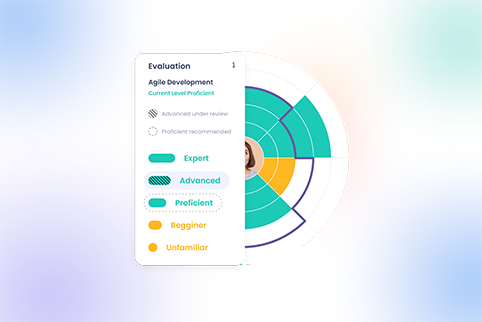Contents
In a world where over 60% of workers will need retraining by 2027 (but only 50% have access), understanding and harnessing the power of individual skills is quickly becoming a cornerstone for organizational success — which is why an increasing number of decision-makers are paying more attention to skills-first approaches.
Here are some eye-opening truths: the traditional way of doing performance management is no longer effective. Gen Zers have other expectations and are more difficult to recruit. Linear career paths have begun to fade as the default or standard choice.
Add in the fact that almost half of the people work in jobs that aren’t related to their formal education, and it’s easy to understand why skills and skills-based initiatives are the new buzzwords in the world of work. According to the WEF, “more than 100 million people in 18 countries could be added to the global talent pool through a skills-first approach.”
With all of that in mind, let’s take a closer look at what a skills-first approach actually implies, what a framework in that direction looks like, and some of the challenges or factors that prevent organizations from making this transition. Let’s dive right in!
What does skills-first mean in the world of business?
A skills-first approach prioritizes the skills and competencies of employees and job candidates. Things like (academic) degrees, certifications, job experience and titles, or other forms of traditional qualifications are no longer considered critical or potential deal-breakers.
In essence, the shift is toward giving more value and encouraging (the adoption of) measurable skills — and accepting that these can be acquired and developed through a wide range of activities, such as:
- previous jobs and tasks
- personal hobbies and passions
- volunteering activities
The value of a skills-first approach also stems from its ability to be applied across the entire talent management lifecycle: from attracting and hiring to developing and even redeploying workers.
It becomes the new common language or currency that enables your HR departments and managers to better evaluate people and align their professional growth with organizational needs.
Companies investing time and dollars in skill management see 11% higher business, talent, and HR outcomes, while organizational innovation improves by 10%. When HR organizations are involved in skills management initiatives, they are 35% more likely to be viewed as strategic.
— Sapient Insights, 2023-2024 HR Systems Survey report
What does a skills-first framework look like?

Based on research from the World Economic Forum, let’s take a closer look at what a Skills-first framework looks like in practice.
1. Identify skill needs, map skills to work tasks, and find gaps
The first step for any organization that is serious about adopting a skills-first approach is to actually gain a complete overview of the skills they have and the skills they need — both now and in the future — to achieve business goals and maintain sustainable levels of growth.
A skills taxonomy is an incredibly powerful tool in that direction. It involves creating clear definitions for various skills and categories (soft, hard, job-related) as well as measurable proficiency levels for each one and mapping them to job titles — the definitions and (skill) levels need to be applied and adopted across all your functions, job families, and departments.
The next step — after evaluating skills through performance reviews, self-assessments, 360 feedback — is leveraging a skills matrix to reveal prevalent or emerging gaps. It represents a quick and simple method of visualizing the real-time skills data of a specific employee or team in relation to their roles or the requirements of a project. For example, here’s what a skills matrix looks like in the Nestor platform:

But why is the use of modern tools to assess and track skills critical? Because it is virtually impossible to collect, organize, and monitor all the evolving skills and proficiency levels across various departments and hundreds, if not thousands of employees with outdated HR tools or Excel spreadsheets.
Moreover, skills assessments are particularly important to validate the level of expertise your workforce has. Companies that don’t keep track of their workforce skills and level of expertise risk being left behind because their people don’t have the right capabilities to execute the business strategy and are not productive.
This is actually one of the main benefits of adopting a skills management software that fits your needs. It simplifies the entire process and brings together skills data and insights from multiple areas — helping your HR teams and leaders understand whether their strategies are achievable and L&D programs are effective.
2. Create job descriptions based on skills and leverage innovative ways to assess skills
The next step is to include the principles of the skills-based approach in the hiring process, external or internal ones. This mainly involves communicating skill needs and expectations in job descriptions and using skills-based methods to evaluate job candidates.
When it comes to skills-first job descriptions, it’s not as simple as just including the skills you’re looking for. According to the WEF report, Putting Skills First: A Framework for Action, you also need to:
- clearly differentiate between required (or must-have) and preferred (or nice-to-have) skills
- eliminate traditional degree requirements, whenever possible or appropriate
- leave industry jargon behind and use simple terms, that can be understood by anyone (generative AI tools like ChatGPT can already help with that)
As for skills-based methods of evaluations, your HR teams together with other stakeholders need to first decide the job positions that qualify for these evaluations. Then, you can start thinking about role-specific tests, such as coding/writing/designing challenges, cognitive ability tests, or problem-solving exercises, among others.
Of course, it’s worth mentioning the obvious: skills-based assessments aren’t enough to make an informed decision on a given candidate. Their personality, mindset as well (proven) ability to learn can be just as important in selecting the right person and ending up with a win-win outcome.
3. Deliver more personalized and effective skills-based training in collaboration with third parties
In an ideal world, companies, industry experts, educational institutions, and other learning providers would collaborate in an organized and transparent manner so that everything from traditional academic curricula to onboarding and L&D programs is aligned with real-world skill needs across various industries.
While progress has been and is being made in that direction, it’s not realistic to expect such an approach to happen overnight. However, individual organizations can reach out to the educational institutions in their areas and offer to help update their courses and tools and nurture students who are much better prepared for their first jobs after graduation.
Internally, companies can create their own targeted development programs to address skill gaps and future redundancies. On one hand, this involves keeping a constant eye on skill and industry trends. On the other, it requires a shift in the scope of L&D initiatives: instead of preparing people for specific jobs or career paths they should help them develop applicable skills that can be used across projects or roles (especially soft skills).
Large companies, like IBM, are taking this type of training to the next level, by providing (free) skills-based courses in an effort to address the talent shortage themselves and equip interested people with desirable skills.
4. Make lifelong learning part of the company culture and provide ongoing skills-based L&D opportunities
To be able to enjoy the status of a skills-first organization, you also need to prioritize lifelong learning and find ways to merge it with skills-based training. At its core, continuous learning is a mindset or an approach that can be developed and adopted by all your employees — when provided with the right incentives. According to a LinkedIn Workplace Learning Report:
L&D innovators are focusing on the convergence of talent development, skill-based planning, and internal mobility to build a work culture based on continuous learning.
And when it comes to internal mobility and ongoing skills-based training, you should take a close look at internal talent marketplaces. For example, Nestor’s talent marketplace brings together all growth opportunities within the company — temporary projects, job shadowing, mentoring, etc. — and enables employees and managers to identify the most suitable next development step for each person.

When implemented well, a talent marketplace with help foster new skills and address existing shortages — all while connecting employees with experiential or on-the-job learning, which keeps them engaged and more satisfied at the current workplace.
Learn how a culture of continuous learning supports skill development.
5. Create flexible career and development pathways based on skills
A skills-first approach also facilitates the change in how both employers and employees perceive career progression. Instead of relying on traditional or linear (upward) progression, skills-based development pathways also enable people to make lateral or cross-departmental moves.
Since jobs are broken down into skills and capabilities, it becomes much easier for managers and team members to identify adjacent career pathways thanks to overlapping skills, which can then be followed by upskilling or reskilling programs to bridge the remaining gaps and prepare employees for their next roles.
In terms of benefits for your workers, they will become much more engaged and satisfied, leading to an increase in retention and loyalty. After all, why leave when growth and development — one of the top 5 reasons people change jobs — is readily available and encouraged at the current workplace?
Your company, on the other hand, will enjoy new levels of flexibility, be better positioned to attract top talent, and avoid undesirable outcomes, like layoffs due to redundancy or other unforeseen developments.
Discover all the benefits of embracing non-linear career paths.
What prevents businesses from adopting a skills-first approach?
Having looked at what a skills-first culture is all about and a framework in that direction, one could wonder: Why aren’t more organizations adopting this type of approach?
There are multiple reasons, but it can be summed up to this: fully embracing a skills-first approach and, implicitly, skills management, is a process that involves significant changes across the entire organization. Specific challenges include:
- Adopting a skills-first approach is often regarded as the sole (or main) responsibility of HR, despite the transition itself requiring the collaboration and involvement of multiple stakeholders and, of course, top leadership.
- It involves the adoption and implementation of new tools and technologies, such as skill taxonomies, matrices, and skills management software that need to be integrated with (or replace some) existing HR solutions.
- To make sure your talented people can easily adapt and find the right opportunities based on skills, you need to use different tools like a talent marketplace, learning experience platforms, talent CRM, ATS, and so on. These tools help connect your whole skills ecosystem, match skills demand with the supply, drive agility and inform decisions about hiring, external or internal, promotions, workforce planning and the best fit L&D initiatives needed.
- Identifying, defining, and measuring skills is challenging and many don’t know how or where to even start.
- Skills management solutions can only yield results when the company strategy itself is aligned with a skills-first approach.
- When expectations aren’t managed accordingly, people can end up expecting skills-management tools to do more than they actually do or to do things they simply aren’t meant to do.
Nestor: Putting skills into action
Although it may seem daunting, it’s critical to start the transition to a skills-first approach now, in order to remain relevant, as an employer, and competitive as a business.
While a company-wide transition might not be feasible in the beginning, you can start by targeting a specific set of skills or a certain team or project that would benefit the most from a skills-first trial and could bring in the necessary insights to make the transition possible on a larger scale.
We have designed Nestor from the ground up as a skills-first People Intelligence Platform, which helps organizations unlock the power of skills to drive workforce agility, high performance, and continuous growth.
Schedule a free demo to discover how we connect performance management, employee engagement, and career development to help HR and business leaders make talent decisions aligned with the changing organizational needs.
Frequently Asked Questions (FAQs) about the skills-first approach
What is a skills-first approach?
Skills-first is an approach to talent management that prioritizes the skills, competencies, and proficiency levels of employees and job candidates over traditional qualifications, like degrees and certifications.
What is a skills-first platform?
A skills-first platform places emphasis on identifying, showcasing, and delivering insights based on the specific skills of a particular person or team in the professional or business environment.
What is skills-first hiring?
Skills-first hiring is a recruitment approach that prioritizes an individual’s specific skills and competencies over traditional factors such as job titles, previous experience, or (academic) qualifications.
A skills-first approach can deliver sustainable economic, business, and societal outcomes. Accessing alternative talent pools to address today's skills and labor shortages enables business model reinvention, fuels profitable growth, job creation, and more inclusive employment opportunities.
— Bhushan Sethi, Partner, Strategy & Principal at PwC








